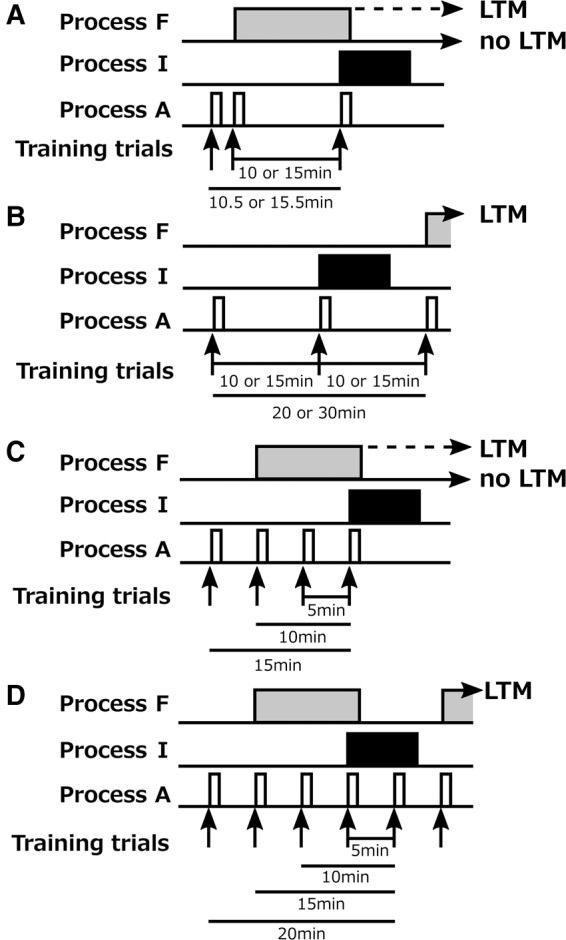Figure 9.

A hypothetical model to account for the effects of number of trials and ITI on LTM formation. The model assumes that (1) each training trial produces transient activation of biochemical process A, (2) multiple activations of process A trigger sustained activation of biochemical process F, (3) sustained activation of process F produces protein synthesis-dependent LTM, (4) the effect of activation of process A to trigger F is weaker when the intervals from preceding activations are >5 min, and thus two trials are sufficient to trigger process F when the ITI is 5 min or less, but three trials are required when the ITI is >5 min, (5) when a trial is preceded by a trial with an interval in the range of 10–16 min, the trial triggers process I, which inhibits process F, and (6) when a trial is preceded by multiple trials, process I is triggered when the number of preceding trials with intervals in the range of 10–16 min is larger than the number of trials with intervals outside this range (<10 min or >16 min). In A, we show how the model accounts for the observation that three-trial conditioning with I1–2 = 30 sec, I2–3 = 10 or 15 min and I1–3 = 10.5 or 15.5 min does not lead to LTM formation (Fig. 8). The second trial triggers process F, but it does not trigger process I. The third trial triggers process I since I1–3 = 10.5 min and I2–3 = 10 min. Process I suppresses process F and thus no LTM formation occurs. In B, we show how the model accounts for the observation that three-trial training with 10-min or 15-min ITIs induced LTM formation but that two-trial training did not (Fig. 6). The second trial triggers process I but not process F, whereas the third trial triggers process F and hence LTM formation occurs. In C and D, we show how the model accounts for the observation that two-, three-, or six-trial training with a 5-min ITI produced LTM but that four- or five-trial training did not (Fig. 7). We observed that five-trial training with 5-min ITIs did not produce LTM, but our model assumes that the fifth trial does not activate process I, since it is preceded by the first to fourth trials for 20, 15, 10, and 5 min and thus the number of trials with intervals in the range of 10–16 min is equal to the number of trials with intervals outside this range (D). We thus added an assumption that activation of process I is maintained for at least 5 min (but not more than 10 min) once it is activated. For mathematical description of the model, see Supplemental Data 1.
